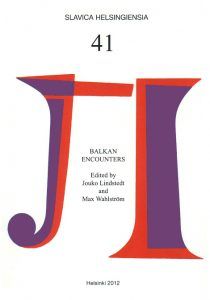This book contains eight scholarly articles whose aim is to analyse the origins, maintenance, and changes of some of the ethnic, linguistic, and regional identities in South-Eastern Europe. Both majority and minority groups are discussed; the modern countries dealt withinclude Albania, Bosnia and Herzegovina, Bulgaria, Greece, Kosovo, Macedonia, and Montenegro. In addition to the main languages of the region, the articles discuss smaller languages and varieties such as Balkan Turkish, Pomak, and Romani, as well as Montenegrin, the newcomer among the Balkan standard languages. In these articles, South-Eastern Europe presents itself as a multifaceted and multilayered scene, where boundaries between different languages and ethnicities, or indeed borders between countries, are much less ancient and much less permanent than they are often conceived.
Slavica Helsingiensia,
published by the Department of Languages at Helsinki University, was founded in 1983. The series includes monographs and collections of articles on linguistic and literary topics.The majority of the doctoral theses prepared in the Department in the field of Slavic languages and literatures have appeared in the series. A certain number of volumes, bearing the sub-heading Studia Russica Helsingiensia at Tartuensia, contain materials from conferences on Russian literature jointly organized by the Universities of Helsinki and Tartu. Further details on the contents of each volume may be found on the website of the series.
This book contains eight scholarly articles whose aim is to analyse the origins, maintenance, and changes of some of the ethnic, linguistic, and regional identities in South-Eastern Europe. Both majority and minority groups are discussed; the modern countries dealt withinclude Albania, Bosnia and Herzegovina, Bulgaria, Greece, Kosovo, Macedonia, and Montenegro. In addition to the main languages of the region, the articles discuss smaller languages and varieties such as Balkan Turkish, Pomak, and Romani, as well as Montenegrin, the newcomer among the Balkan standard languages. In these articles, South-Eastern Europe presents itself as a multifaceted and multilayered scene, where boundaries between different languages and ethnicities, or indeed borders between countries, are much less ancient and much less permanent than they are often conceived.
Slavica Helsingiensia,
published by the Department of Languages at Helsinki University, was founded in 1983. The series includes monographs and collections of articles on linguistic and literary topics.The majority of the doctoral theses prepared in the Department in the field of Slavic languages and literatures have appeared in the series. A certain number of volumes, bearing the sub-heading Studia Russica Helsingiensia at Tartuensia, contain materials from conferences on Russian literature jointly organized by the Universities of Helsinki and Tartu. Further details on the contents of each volume may be found on the website of the series.













